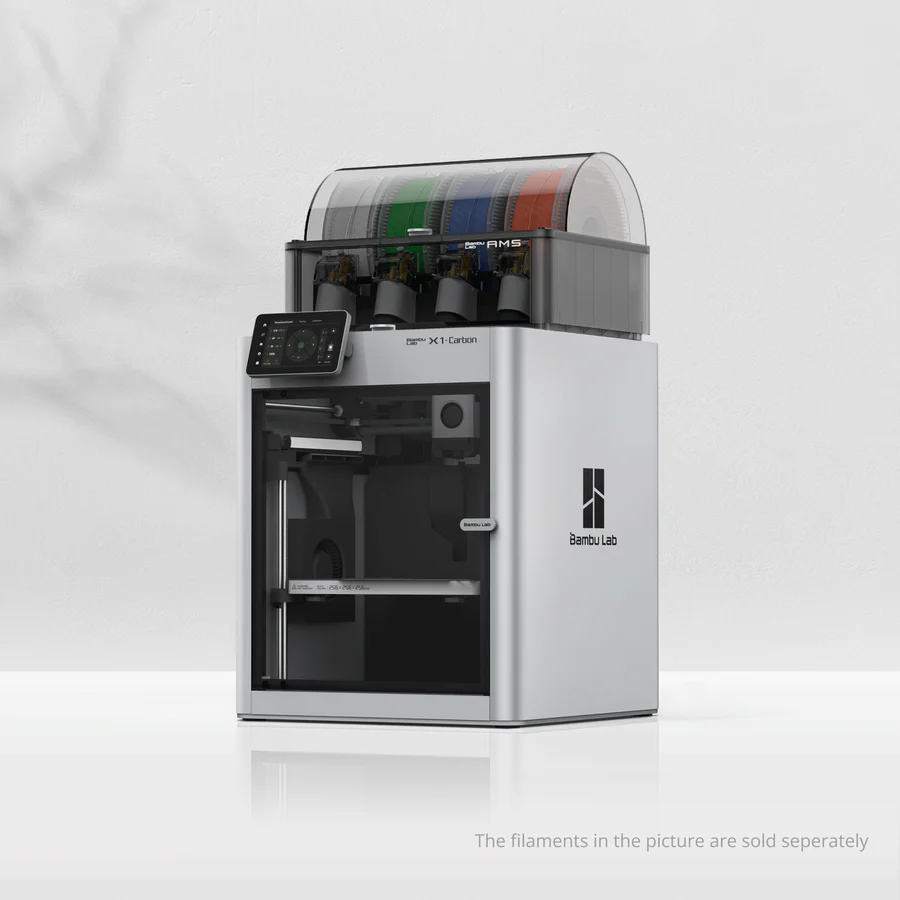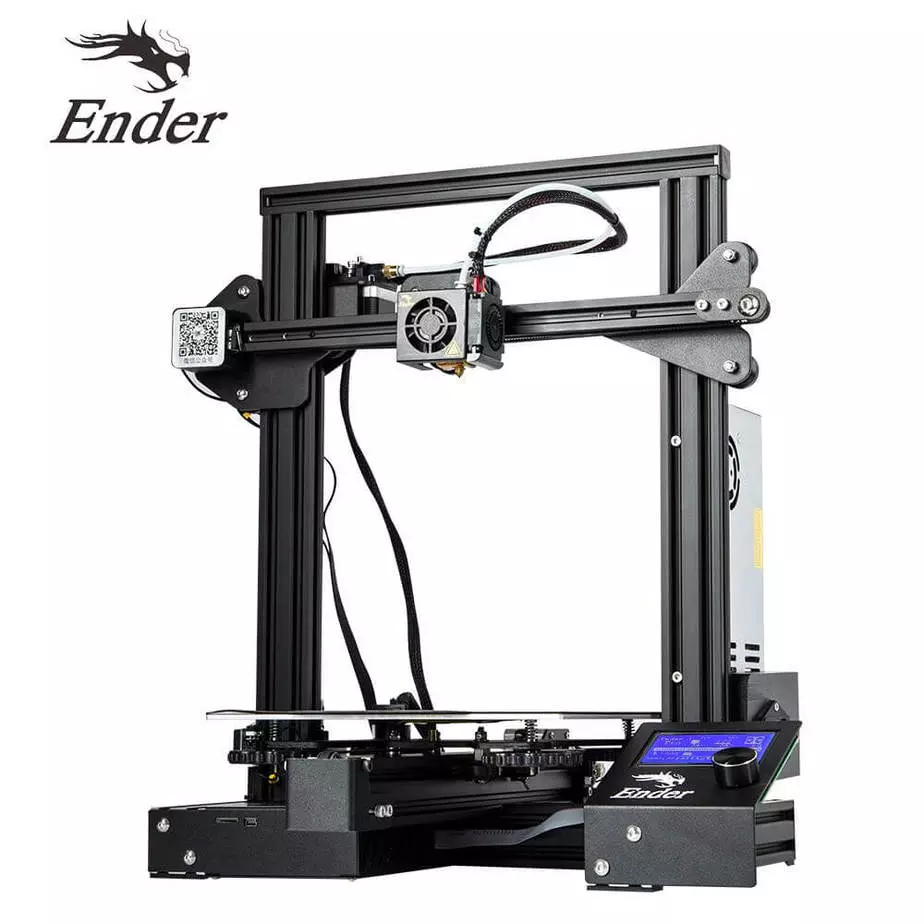Compare X1 carbon vs Ender 3 PRO
Comparison between the best 3D printers
Choose the best 3D printer at the best price. The cheapest 3D printers are here.
Buy a 3D printer here with 3D Fila.
 |
 |
|
| Model | X1 carbon |
Ender 3 PRO[BUY Ender 3 PRO] |
| Printing Material | Filament | Filament |
| Buy Filament for Bambu Lab X1 carbon | Buy Filament forCreality 3D Ender 3 PRO | |
| Estimated price | $1449,00 | $258,00 |
| Manufacturer | Bambu Lab | Creality 3D |
| Release Year | 2023 | 2019 |
| Print Volume [mm] | 256x256x256 | 220x220x250 |
| Printer Size [mm] | 389x389x457 | 440x440x465 |
| Weight [kg] | 14,13 | 6,62 |
| Power Loss Recovery | YES | NO |
| Enclosed printer | YES | NO |
| Bed Leveling | Automatic | Manual |
| Filament End Sensor | YES | NO |
| Bed type | Heated | Heated |
| Power supply system | Direct Drive | Bowden |
| Standard nozzle | 0,4 | 0,4 |
| Maximum Nozzle Temperature [°C] | 300 | 255 |
| Maximum Bed Temperature [°C] | 120 | 110 |
| Maximum printing speed [mm/s] | 500 | 180 |
| Filament holder | YES | YES |
| Camera for supervision | YES | YES |
| Recommended filaments | PLA, PETG, TPU, PVA, PA, PA-CF, Nylon, PC | PLA, TPU, ABS, PETG |
| Recommended slicers | Bambu Studio, Super Slicer, Cura, Prusa Slicer, Orca | Cura, Simplify, Slic3r |
| Maximum Resolution [mm] | 0,1 | 0,1 |
| Processor | Quad ARM A7 1.2 GHz | 32 bits |
| Display | Touchscreen 5'' | Mono |
| Power Supply | 350 W | 24V / 360W Meanwell |
| Connectivity | Wifi, Bambu bus, Cartão SD | SD / USB |
| Operating systems | Windows, Linux, Macbook | Windows, Mac, Linux |
| Date of registration in the system | 2024-04-10 | 2021-04-14 |
| Release date | 2023 | 2019 |
| Extra features | The Bambu Lab X1 Carbon revolutionizes 3D printing with stunning design, high print speeds, and a streamlined user experience. It stands out with its CoreXY system, a hotend capable of reaching 300°C, allowing for a wide range of filaments. Its LiDAR-assisted bed leveling system, vibration compensation, and AMS multicolor printing capability raise the industry standard. Print quality is impressive, with the ability to fine-tune for perfection. The X1 Carbon, with its closed build volume, not only promises but also delivers one of the most advanced 3D printing experiences available to consumers. | The Ender 3 Pro stands out for its beginner-friendly assembly and easily modifiable structure. With a 350W power supply, it heats up quickly and has a simple application that offers good print quality. However, its motors and fans are noisy, and the interface seems outdated. Assembly is accessible, without the need for advanced techniques, and it has integrated belt tensioners. It includes a detailed guide and supports microSD card and USB. |
| Support for multiple colors and materials (AMS and CFS) | YES | NO |
Notes * |
||
| Cost-benefit | 7 / 10 | 6 / 10 |
| Hardware | 6.4 / 10 | 0.5 / 10 |
| Tela | . | . |
| Print volume | 4 / 10 | 3 / 10 |
| Performance | 4 / 10 | 1 / 10 |
| [BUY Ender 3 PRO] |
Conclusion |
| In comparing the Bambu Lab X1 Carbon and the Creality 3D Ender 3 Pro, several critical factors emerge, leading to a clear distinction between the two printers. The Bambu Lab X1 Carbon, released in 2023, presents itself as a high-end solution with an array of advanced features. Its automatic bed leveling, power loss recovery, and the capability to print with a wider range of materials at higher temperatures highlight its suitability for professional and demanding users. The enclosed design and high print speed provide an efficient and user-friendly experience, making it ideal for more complex and varied projects. Conversely, the Ender 3 Pro, launched in 2019, is a cost-effective choice for beginners and hobbyists. While it lacks many of the sophisticated features of the X1 Carbon, such as automatic leveling and dual-color printing capabilities, it offers a solid introduction to 3D printing with its straightforward assembly and compatibility with standard filaments. Its more manual operation may require an investment of time to achieve optimal results, making it less suitable for users looking for plug-and-play functionality. Despite both printers demonstrating good print quality, the Bambu Lab X1 Carbon excels in performance and technology, warranting its higher price tag. Meanwhile, the Ender 3 Pro provides great value for those entering the 3D printing arena or for casual projects. Ultimately, the choice should align with the user's specific needs—whether seeking advanced capabilities and higher efficiency or a budget-friendly, user-oriented machine. |

